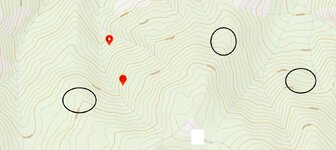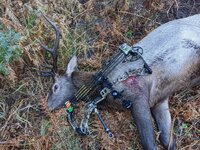If you're for sure focusing on pre-rut, the bulls will not have cows with them yet and you may be able to get more solo encounters with them, especially larger bulls that will have more eyes and ears around them as the rut gets going.
If your schedule is still flexible to you, I did my first archery elk hunt two seasons ago and can recommend picking a unit you can get to more regularly than planning the hunt as one long trip. It makes preseason scouting more accessible and gives you more time to recover, regear, research, and learn how the elk use an area over the course of the season. I would say it was crucial to my success to have that time between outings, as archery elk was a massive, massive learning curve to start into, not to mention physically depleting. It was my eighth day and the last day of the season in the rain that I finally got my bull, and I wouldn't have known how to find him that day if I hadn't been studying their patterns and learning the local landscape for the few weeks prior. There was a big change in elk activity from week to week between hunting pressure, weather, and herd dynamics. The most active windows were not always when I expected. Weekdays were generally better from the reduced hunter and recreator pressure.
Hiking and glassing in the late summer and early fall to locate big herds was helpful for getting a general place to start. I hiked to find small areas with a high density of rubs as a clue to where they might be then rutting around in September. Often, but not always, this was not too far above some water source or wetter area. The rubs are more about staging for the rut so it's not always the same place you want to hunt, but it's close. It was also helpful to estimate hunter pressure from camp and trail developments, then pick my own camp and walk in points based on what I found in the woods.
Both hunter pressure and elk moved around during the hunt, so I ended up using a few of my planned access points to stay near the elk over the season. There were some bigger trailheads and outfitter camps that I tried to stay away from. Cliff Gray recommends getting to places that can't be easily glassed. This doesn't always mean far away. Cliff shares a ton of knowledge, especially on Colorado hunting, and just started a new podcast now that he's out of the outfitter game.
Transition zones from dark timber to aspen were a good place to find elk at first light. The elk moved down overnight to feed, even going out to the roaded areas, and were just getting back into timber at or even before shooting light. This was the best time to spot elk moving back to cover, catch regathering calls and bugles as they adjusted their groups, and get a lead on where they might be headed to bed down and feed during the day so I could track and still hunt my way after them. I encountered a number of lone and curious bulls in the thicker stuff more in between where the herds seemed to be going, but this was after pre rut when the herds were more developed. It might be the same early season with bulls moving around in the mix.
ElkNut has a great app for learning all kinds of calling tactics. The simple stuff works well. I'd locate bugle my way into a talkative bull, then try to go slow and use soft cow calls when I was within a few hundred yards, working my way to the same elevation line as the bull while being mindful of prevailing wind and thermals. Cory Jacobsen has lots of info on approach and call tactics. Being the same elevation seems to make them more likely to approach your call rather than them standing and waiting to spot you. I've cow called my way directly up to shot distance on a young bugling bachelor bull on a muzzleloader hunt. He stood and waited for me. I don't know if I'd have taken the shot with a bow. If it's early season you may be able to find some more aggressive sounding bulls that want to shake down who's who and aggressive bugling may bring them in. Cow calls seems to be the more reliable approach, as you could scare a bull off the same way if he's not looking to fight.
Elk love thick stuff, and steep stuff. Extreme blow down can filter their movements somewhat, but they use a lot nastier stuff than you'd expect for cover, shade, and barriers to hunters. If you're moving along a benchy ridge or hill side and come upon some dark timber that's suddenly so thick you have to squeeze yourself through the branches, be ready to find some bedded elk. Move very slowly and use binoculars to look through the layers of openings.
Exploring on foot and evaluating recency of sign has taught me more about elk habits and preferences than glassing or reading topos, but glassing during archery can help to understand the landscape, and occasionally, spot some far off elk to go after.
On topos, elk tend to bed on benchy areas about 2/3s up the ridge, often on the cooler, wetter north faces. I've also found them on extremely steep, grassy but thickly wooded hillsides on the south face, but I think this was spring fed so it wasn't as dry as the south faces tend to be. You wouldn't know this unless you walked or followed tracks in to where they were. Following game trails can teach you a lot.. The cows are always going to be eating, so topo areas with lots of creek lines and undulating pockets to catch water and grow plants with an adjacent benchy hillside are good. Canopy disruptions like fire or beetle kill can have good food. Randy Newberg has some good stuff about E-scouting with topos and trail maps.
If you have a buddy to hunt with then check out Remi Warren's podcasts on the two man roll, it's a great system for getting better shot opportunities when calling in a bull. Plus, giving hand signs to your buddy in the woods as you stalk in on a bull is just a good time.
If you haven't bow hunted before, aim low when you do get a shot. Arrows don't hit or kill animals like bullets do and the further above mid body cavity you go the slower the kill and the harder the tracking will be. You want it lower in the lungs or in the heart. Practice it on some 3D and even sign up for a TAC if you can. It is a very humbling experience to let an arrow go in more realistic terrain.
Have fun, and be ready for the lowest of lows and highest of highs that is archery elk hunting.


